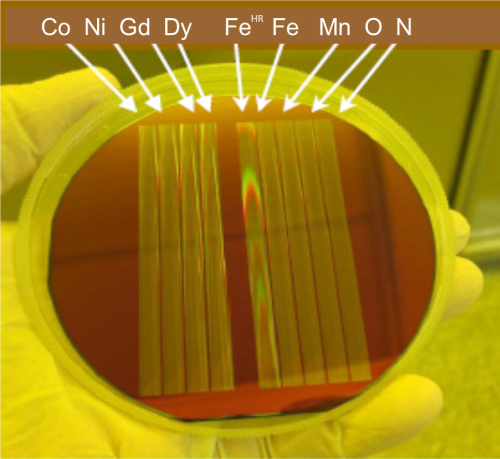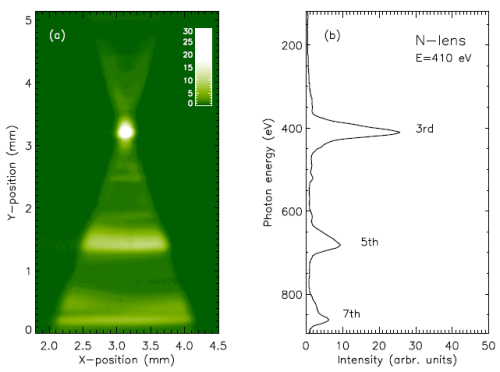Femtoslicing facility successfully upgraded: New opportunities in ultrafast x-ray science

The heart oft the new Zone-Plate monochromator for ultrafast
science with FEMTOSLICING is an array of
so-called reflection zone plates. These diffractive optical
elements cover the photon energy range from
410 to 1333 eV and are completely manufactured
in-house at HZB.
(courtesy A. Firsov, M. Brzhezinskaya).

CCD image oft the dispersion plane 5.08 m behind
the Nitrogen lens (N) at 410 eV emitted from
the 3rd harmonic oft the UE56/1 (a) and a corresponding
vertical linescan (b) showing up the 5th and 7th harmonics
off horizontal focus.
( © K. Holldack
Ultrashort X-ray pulses are an indispensable tool to visualize ultrafast processes in solids and liquids. In order to generate them at the BESSY II storage ring employing Femtoslicing, ultrashort laser pulses co-propoagate with the relativistic electrons in an undulator while exciting them to emit x-ray pulses of only 100 fs duration, a time range of atomic ordering phenomena in solids.
While Femtoslicing has been gradually upgraded over the past few years, in the recent upgrade it was all about a novel Zone Plate Monochromator (ZPM). This special high-flux beamline has been completely re-designed, built and commissioned in 2012 in a close collaboration between the Institute for Methods and Instrumentation in Synchrotron Radiation Research and the Institute for Nanometer Optics and Technology.
“After successful commissioning we can now state that all initially envisaged goals have been more than achieved: smaller focus, improved resolution and excellent long term stability. Current users are delighted”, says Dr. Karsten Holldack who has been heading up the Femtoslicing upgrade projects.
Together with the Top-Up mode of the storage ring and increased duty cycle of 6 kHz, a new class of exciting ultrafast applications with variable optical excitation wavelength can now be addressed.
Funding was kindly provided on a short term basis by internal funding via a strategic investment fund of the HZB.
https://www.helmholtz-berlin.de/pubbin/news_seite?nid=13644;sprache=en
- Copy link
-
MAX IV and BESSY II initiate new collaboration to advance materials science
Swedish national synchrotron laboratory MAX IV and Helmholtz-Zentrum Berlin (HZB) with BESSY II light source jointly announce the signing of a 5-year Cooperation Agreement. The new agreement establishes a framework to strengthen cooperation for operational and technological development in the highlighted fields of accelerator research and development, beamlines and optics, endstations and sample environments as well as digitalisation and data science.
-
Solar cells on moon glass for a future base on the moon
Future settlements on the moon will need energy, which could be supplied by photovoltaics. However, launching material into space is expensive – transporting one kilogram to the moon costs one million euros. But there are also resources on the moon that can be used. A research team led by Dr. Felix Lang of the University of Potsdam and Dr. Stefan Linke of the Technical University of Berlin have now produced the required glass from ‘moon dust’ (regolith) and coated it with perovskite. This could save up to 99 percent of the weight needed to produce PV modules on the moon. The team tested the radiation tolerance of the solar cells at the proton accelerator of the HZB.
-
Accelerator Physics: First electron beam in SEALab
The SEALab team at HZB has achieved a world first by generating an electron beam from a multi-alkali (Na-K-Sb) photocathode and accelerating it to relativistic energies in a superconducting radiofrequency accelerator (SRF photoinjector). This is a real breakthrough and opens up new options for accelerator physics.
